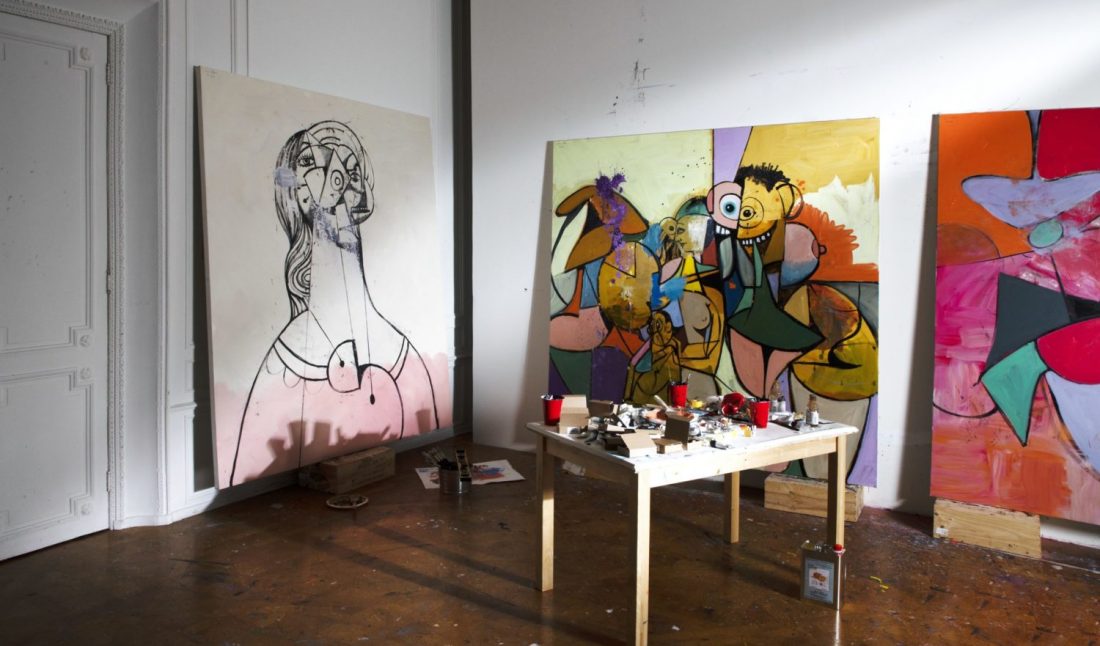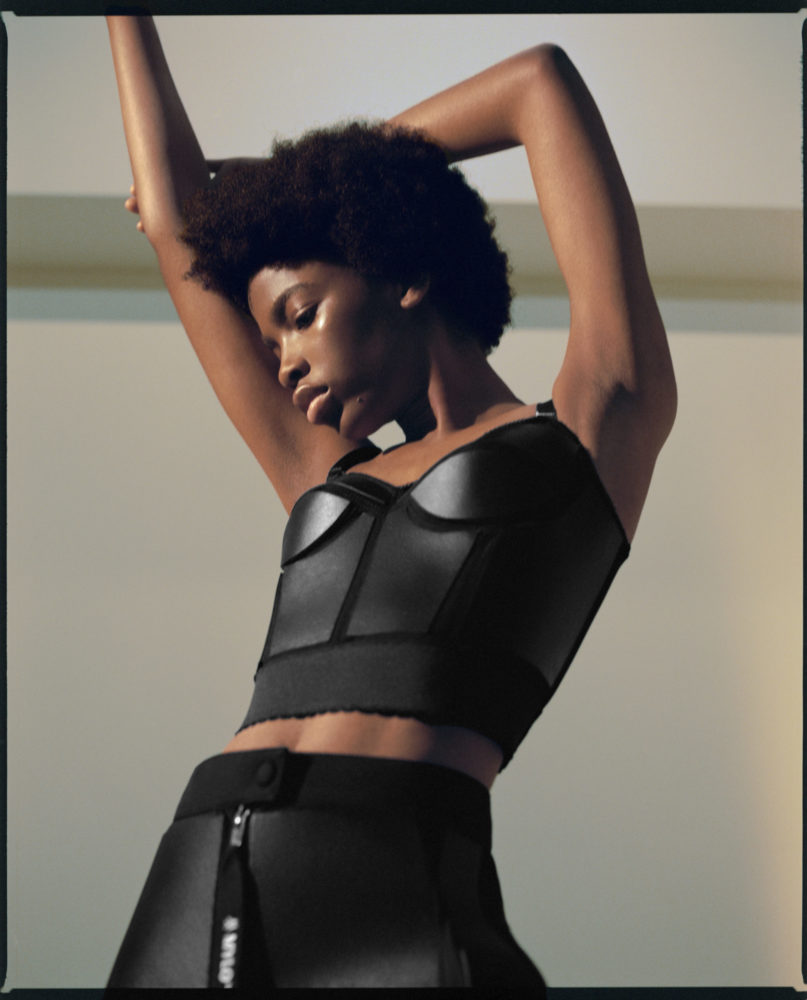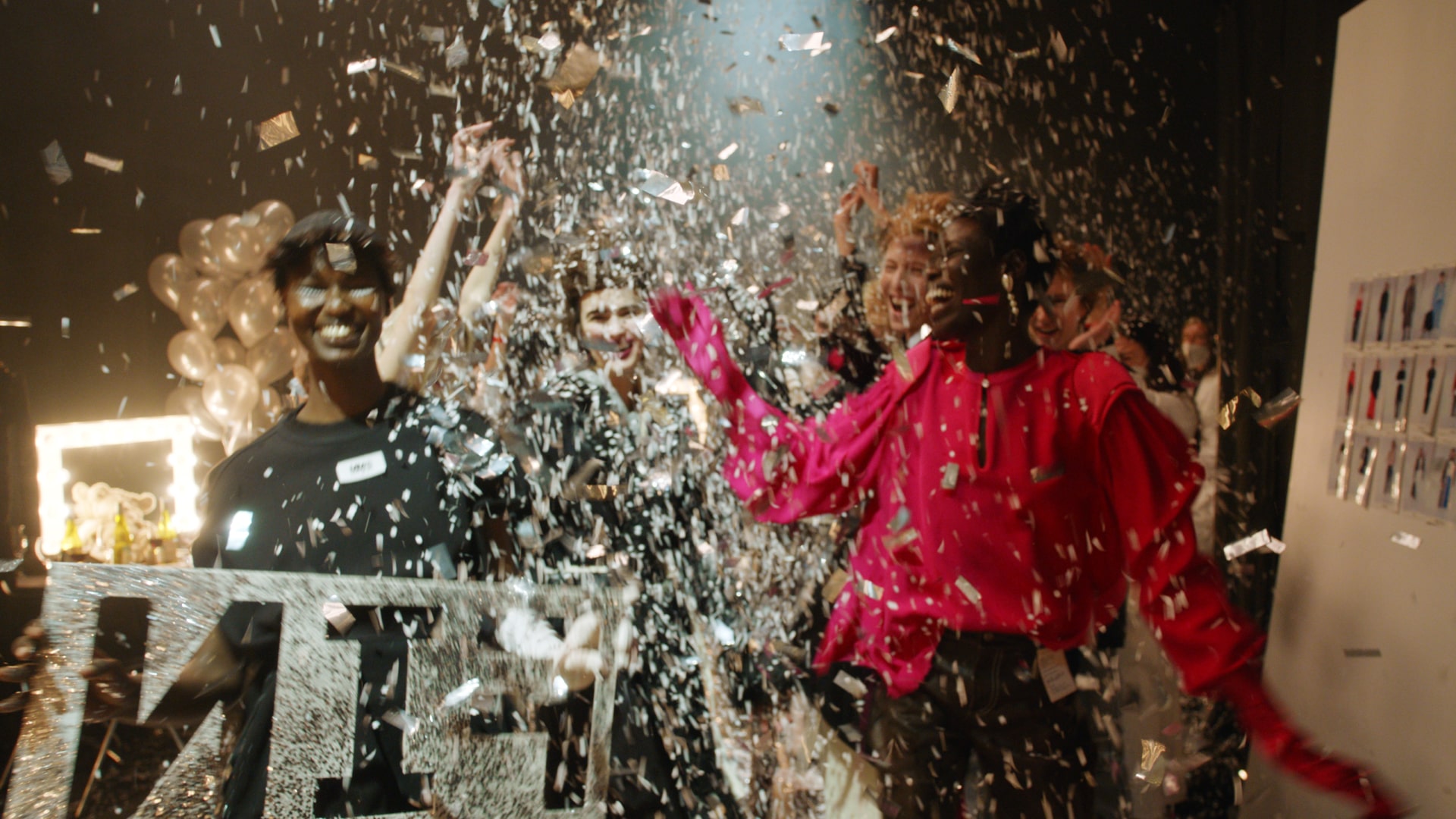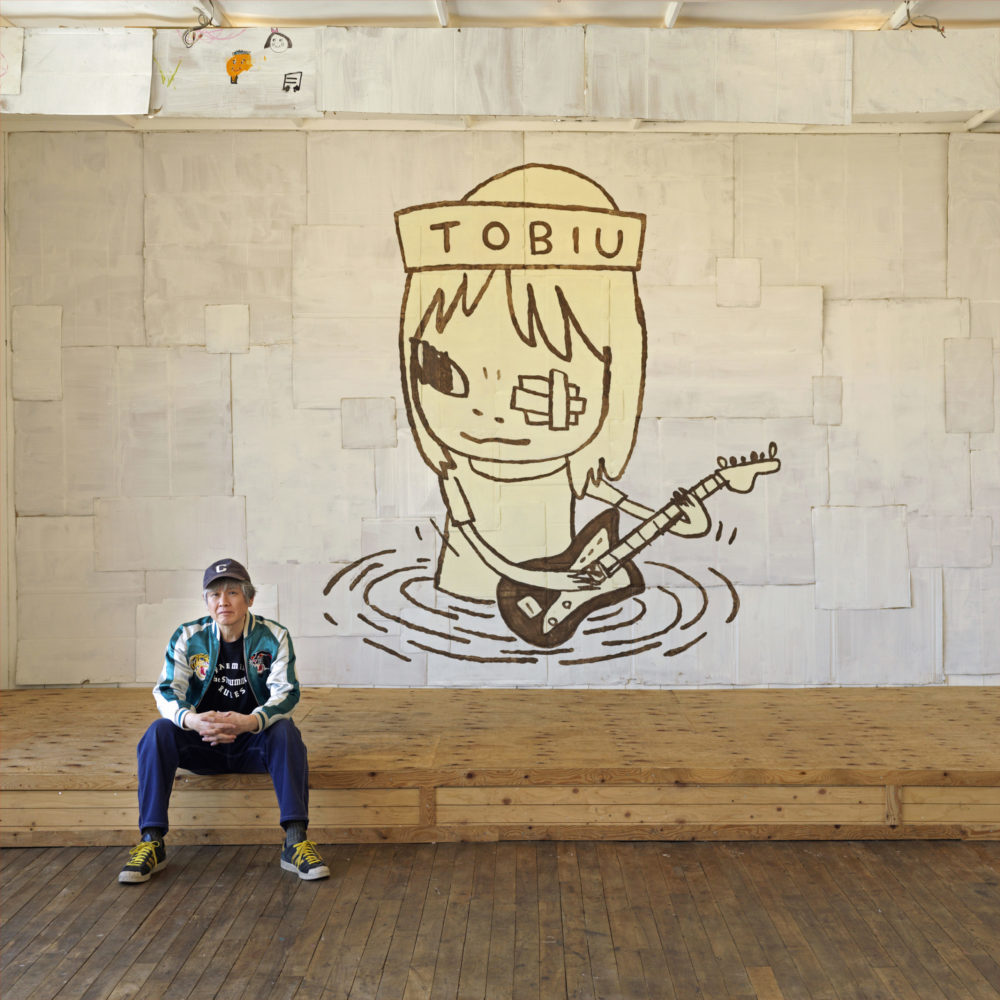George Condo’s “The Picture Gallery” is on view at the Long Museum West Bund in Shanghai this fall through late November. The largest solo show of the artist’s work in Asia to date, it has been curated by Massimiliano Gioni and features over 200 paintings created from the late 1970s to today. Rather than moving chronologically through the artist’s storied career, the exhibition showcases cycles in his conceptual art practice, with some works installed salon-style, as the title suggests.
Putting together “The Picture Gallery” early this year with Gioni, Condo found himself revisiting old friends—literally and figuratively. Looking at paintings he hadn’t seen in many years, even decades, he found himself reminiscing about the time in his life when each was made. On a recent Zoom call, he told Whitewall that these encounters with paintings past inspired him to remember some of his pals from the time of their making.
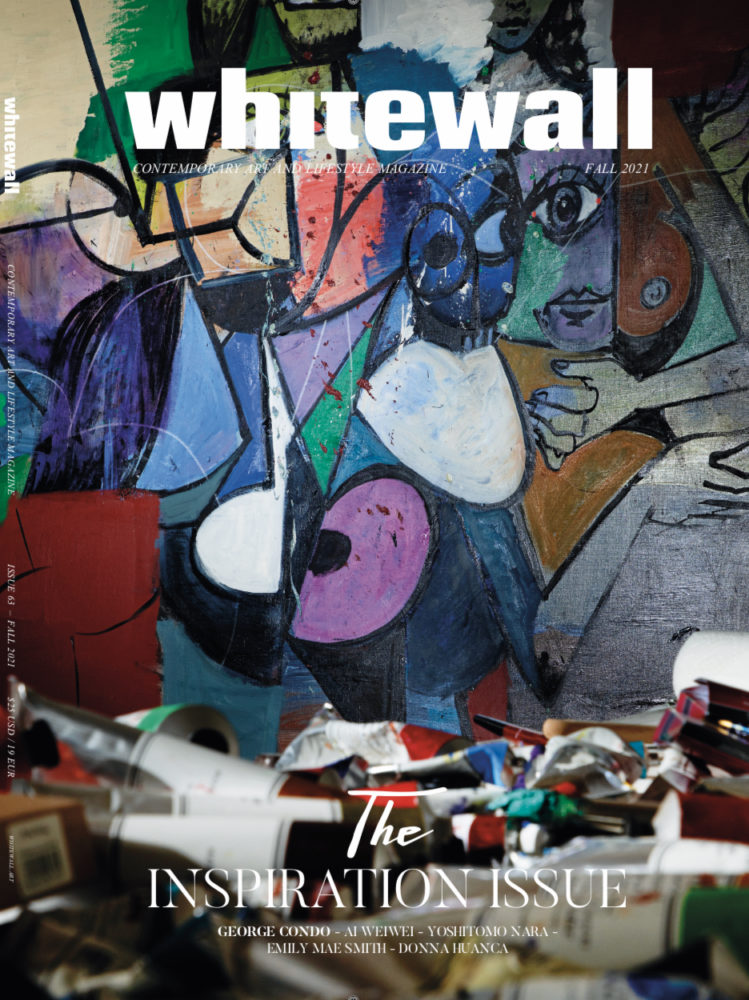 George Condo’s New York studio, photo by Steve Benisty.
George Condo’s New York studio, photo by Steve Benisty.
Condo’s psychologically charged paintings exist between figuration and abstraction, reality and dream. He paints from his mind’s eye, usually with speed and intensity, though sometimes more slowly and always with intention. He readily relates his intuition for color and composition to music, like a jazz musician’s ability to improvise between chord changes. Viewing his work, there is obvious rhythm and movement, as well as an opportunity to see one’s self, mood, or experience—as in his recent “Internal Riot” exhibition, presented by Hauser & Wirth last winter, a response to the ongoing pandemic capturing our collective fractured and delicate psychological states.
His latest work, created more recently as his home city of New York has reopened and the pleasures of summer and travel have been reignited thanks to the COVID-19 vaccine, Condo describes as wild and full of freedom. It will be part of his forthcoming exhibition at Hauser & Wirth in London (October 13–December 23, 2021). The artist shared with Whitewall about how, looking back, he has realized that his imagination has never been bound to reality.
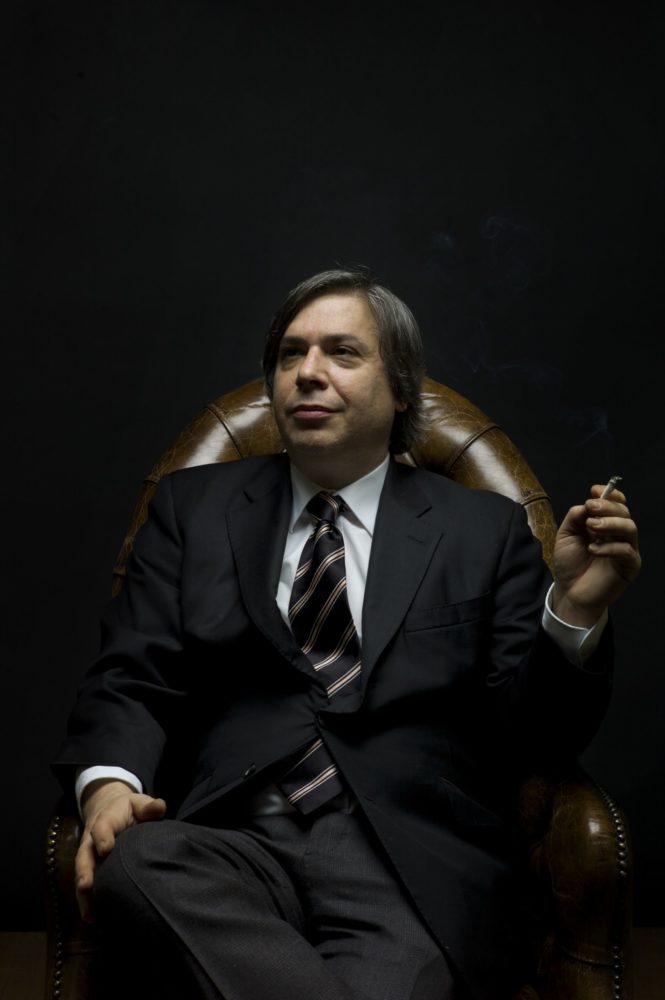 Portrait © George Condo, photo by Sophie Caby.
Portrait © George Condo, photo by Sophie Caby.
WHITEWALL: What was the starting point for “The Picture Gallery” at the Long Museum in Shanghai?
GEORGE CONDO: The Long Museum said they’d love to do a show of my work. It would be the first exhibition of it in mainland China. Then the question was, who would be the curator? I always felt that Massimiliano Gioni would curate the show. That was the starting point, and then we started to look at artworks and get involved with the idea of what are the basic concepts that we were going to explore.
The idea was that the show would explore cycles of work as opposed to series. A series seems to be a finite set of works, whereas a cycle is an infinite type of thing where you can come back to something many years later. It was interesting to come back around to earlier works that ft together with newer works.
The concept is really the work and then how to bring an audience to understand the complete body, from the very beginning, since I started making paintings and drawings to where we are today.
WW: What was it like working with Massimiliano Gioni?
GC: It was a natural fit and an easy one for me because we know how each other thinks. I know how great the shows he’s curated are, how he finds his way into a new kind of presentation or unknown territory of an artist.
My personal collection I don’t usually share with anybody outside of myself. Seeing certain things that I’ve kept for forty to fifty years, it was okay to do that with Massimiliano because I know him so well. Some of these works that will be in the show will never have been seen before—a lot of works just because I’ve kept them for many years because I liked them.
WW: How will the concept for “The Picture Gallery” influence the installation of the show?
GC: I’m hoping for a feeling with the portrait paintings, almost like an imaginary wall of a salon hang. It will exhibit simultaneous joy, horror, conflict, resolution—all different things that are happening in the mind of the portrait. I’m hoping the viewer will be able to transpose their own thoughts: “Oh, I’ve felt that way before,” “This looks like me on a bad day,” “This looks like me on a good day.” And so the idea was to say, these are a lineage of figures from my own, let’s call it, encyclopedia of imagined subjects, and they come from extracting various different presences from paintings that have been seen in museums and people in the street. This is an imaginary court of characters that are made up of the imagination.
WW: As the exhibition surveys your entire career, what was it like to revisit some of your older works?
GC: I’m always thinking about the next painting. In the normal practice of painting for me, when I finish a painting, I turn it around against a wall so I don’t see it, and I start again from white canvas. So, all of a sudden I’m in a sea of art that I’ve made over the last year forty years since I was in my early twenties and even before. And coming back to look at them, I thought, “How interesting that that idea skipped ten years and came back again into another painting, and then skipped another five years and came back.”
It was a nice experience, and it was a qualitative experience, in the sense that I didn’t think that the quality of the earlier works was any less interesting than the quality of the newer works. Where a lot of people say, “Oh, you got better and better and better,” and I thought, “I don’t know if I ever got better.” I don’t know if I ever got worse, but I know I never got better than before I ever heard of an art world, before I even knew there was such a thing as the art world. When I was just growing up in a small town with apple trees and cows and I was making artworks, and reading books, and studying classical music, and thinking there are these incredible things one needs to know in order to get to the point where these artists and these musicians I admire have reached.
Looking back at my work, I could see what I was thinking about, what I was reading, what I was transcribing in my mind as a sort of a mental image. My mind, my brain, works like a photograph. I see something and I transcribe what the image in my brain is onto the canvas. I don’t really work from life anymore; I like to draw things just straight out of my brain. I realized looking at my earlier works, it’s just like that. It was always like that. My imagination was never restricted by reality.
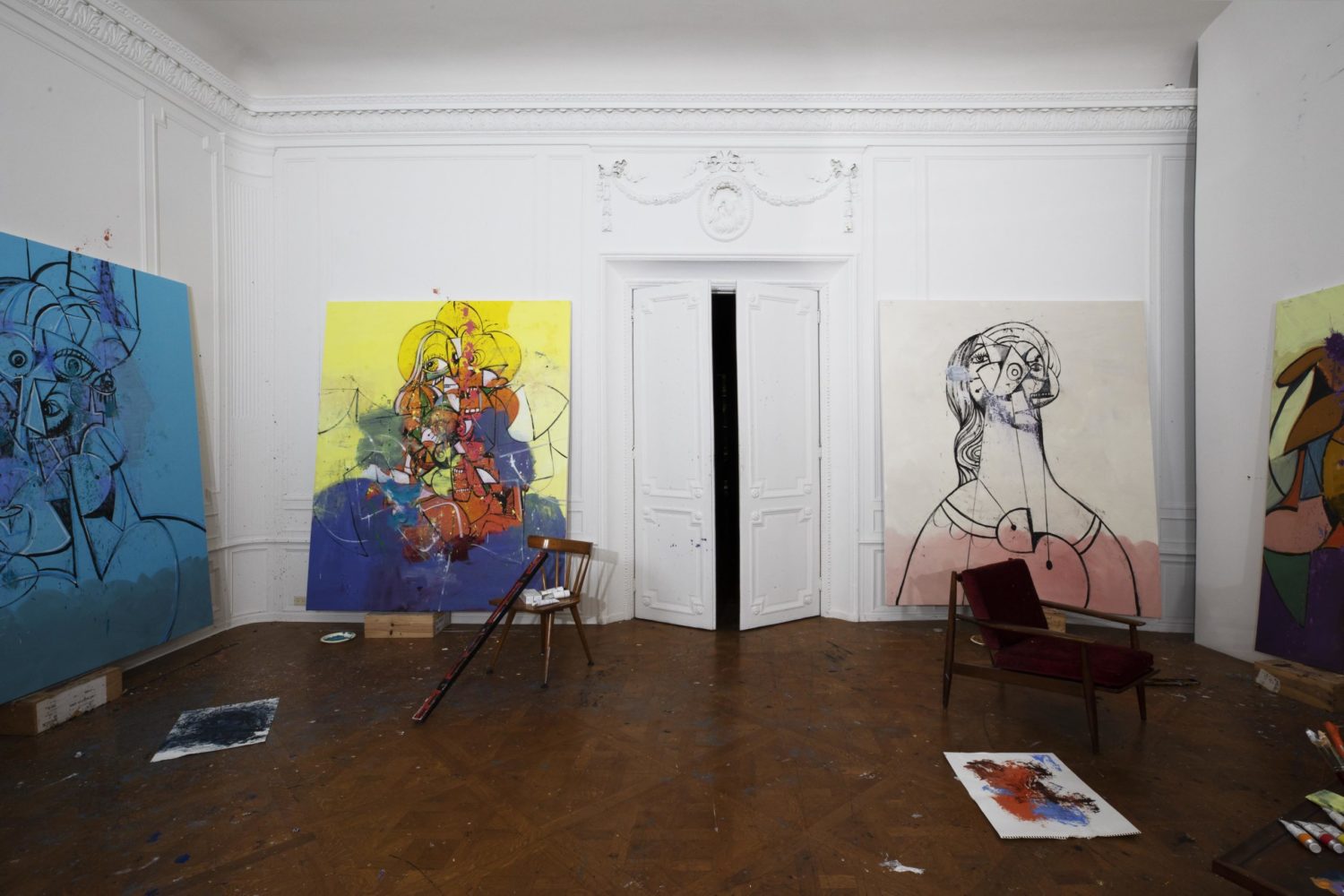 George Condo’s New York studio, photo by Steve Benisty.
George Condo’s New York studio, photo by Steve Benisty.
WW: It’s a direct connection between your mind and the work?
GC: A pure transmission from what’s in your mind to what goes straight onto the canvas—that’s a practice I’ve always had. I think that some of the great jazz musicians, about how so few of them in the past went to music college. If they had, it probably would have destroyed them to a certain degree, kept them from being great jazz musicians.
I will set up in a painting a number of patterns of color, a random field of color that I consider to be almost like the chord changes. The improvisation over those chord changes means you need to know what each and every one of those chord changes represents in terms of all the notes in the key signature, all the notes in the scale, all the modal harmonies and outside harmonies, and be able to move through these passages of color at very extreme, lightning speed or very slowly. So tempo is a very important aspect of my work in that sense.
I think that if you don’t catch an image as it arrives in your brain— when it’s in your head—you need to get it out. That’s why I paint every day, because it’s always full of something. I do think that the idea of immediate transmission of thought into image is an interesting way of going about making work.
WW: Are you aware of how the images come to your mind? Is there a way you prepare to focus on them, like a meditation or exercise?
GC: I don’t really know. It’s an automatic situation where if I separate my mind into two parts, one part looks at the other, which I think is something you do with meditation. You watch your mind and you observe what’s coming and going. I’m not necessarily trying to escape the images; I’m definitely looking at them in my mind. Once I’ve defined an image, I then try to focus it like a camera until it’s sharp, and then I can take that image from my head and put it onto the canvas or a piece of paper.
I can’t tell you where they come from, but they do come from observations in the real world. They come from expressions I see. They come from watching all these moments, the pain and suffering, revolutions that take place in our society. I’ll watch and see what these reactions create on the human face, and you want to capture that expression in your painting.
WW: Many of the pieces, you mentioned, have been rarely or never seen. Were there any old friends you were reunited with for this show?
GC: Yeah, there were numbers of them, paintings I hadn’t seen for ages. In a metaphorical sense, they are old friends. And funny enough, in looking at older paintings from the early eighties, it brought me back to the older friends that were really friends—like Keith Haring or Jean-Michel Basquiat—thinking, “Oh, I remember Jean-Michel was at my apartment on the rue de Condé when I did the ‘Expanding Canvases.’” And I remember Keith and I working together, we went to see our friend who went to the hospital and we did a couple of paintings together. We painted through the night to quiet our minds to try and keep him alive, and then he lived. The next day we heard our friend made it out of the hospital. We were like, so our collaboration worked!
In a funny way, what you say is interesting—in seeing pictures you remember the time that those pictures were made. For me, the paintings are like family photos, and so they are old friends as artworks, and they are also bring up memories of the friends that were around during the time those artworks were made. There’s something sweet about revisiting that, you know.
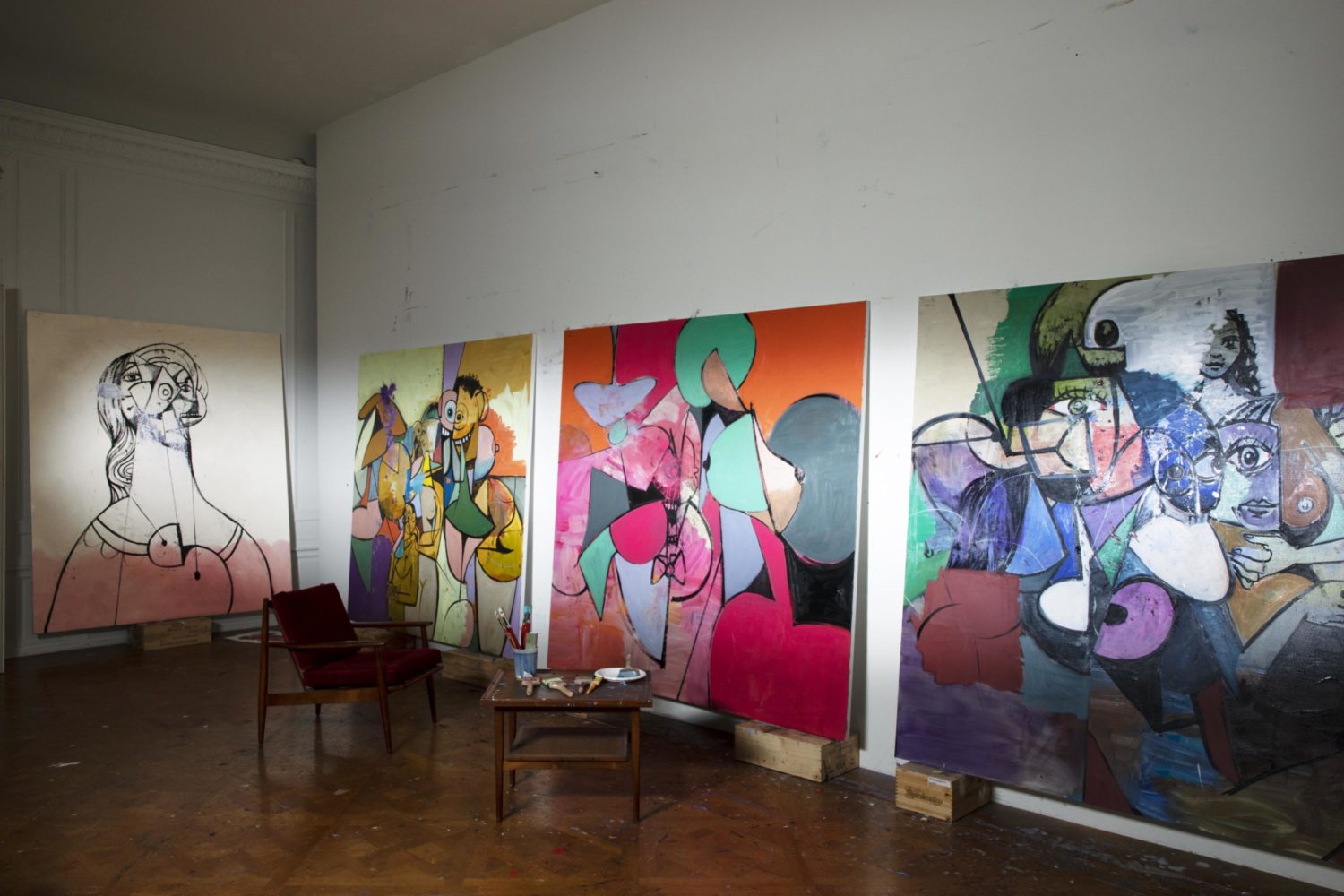 George Condo’s New York studio, photo by Steve Benisty.
George Condo’s New York studio, photo by Steve Benisty.
WW: You also made new paintings for the show at the Long Museum. Can you tell us more details about that new work?
GC: It was toward the point where the pandemic had quieted down and people started to get the vaccine in America. I had been living out in the countryside for over a year out of New York and it was terribly boring. I wanted to come back into the city. And as everybody started getting the vaccines, there was a kind of sort of strange malaise of the world going back to normal. I’ve gotten so adjusted to the new abnormal, how will I get back to the new normal? It brought me down.
Then I started to listen to a lot of blues music, and I realized I wanted to do a series of paintings, a whole body of work, based on listening and feeling like I really do understand this feeling of the blues. Like, “Oh boy. Here comes life again.” Here comes the sadness of everyone who has suffered losses, and the sadness of coming back to a kind of reality that you had escaped from through the last year and a half.
I started listening to more blues music and setting up passages of blues that were mixed with slight variations. Then I’d come back and simply get a little thing, one instrument. I’m the sax player, I’m the guitar player, I’ve got my one instrument, which is just paintbrush and a little cup of black paint, and I started to paint whatever comes to my mind.
It’s a moment of happiness that brings an ironic twist to the blues with it. We’re so used to isolation. To a certain degree we’ve all been in this prison of our own creation. That’s kind of that blues of getting out of, back into the real world, I guess.
But now I’m over it. Now I feel much more euphoric. Now I feel really happy to be out in the real world and to be able to go to dinner and not wear a mask and see friends that I hadn’t seen in years.
WW: How does your love of music influence your drawing and painting practice?
GC: Its influence is in understanding that there’s a lyrical aspect to painting. I studied music but I’m not a great player. But I studied music theory. I think that music and art have very similar language in the sense that if you divide one note into 12 different notes, and then you think about the color blue divided into twelve shades of blue, and you start to work with all those different shades of blue (and you think about Miles Davis’s Kind of Blue), you start to improvise over those chord changes like the way someone like Miles Davis improvises. It’s a complete understanding of the breakdown of the colors, the same way in music it’s a breakdown of the chord changes.
Sometimes in music, the tempo is extremely quick, like you’re working very quick, but it doesn’t mean you can miss a note. Other times you want to sit back and think, “I want this to be a slow piece of music, like a ballad.” There’s a sort of spectral organization of note languages or painting languages that you’re going to bounce from one place to the next very quickly.
The pitch of the painting is very much related to the pitch of a certain piece of music. It needs to be in perfect pitch, but then you also have a lot of registers; there’s a lot of low notes and high notes and hidden figures in paintings. And in a strange way, a kind of concept of perspective is involved. One portrait can be an orchestral piece. It doesn’t mean that there are a thousand instruments heard at once; it just means there are a thousand dimensions seen at once.
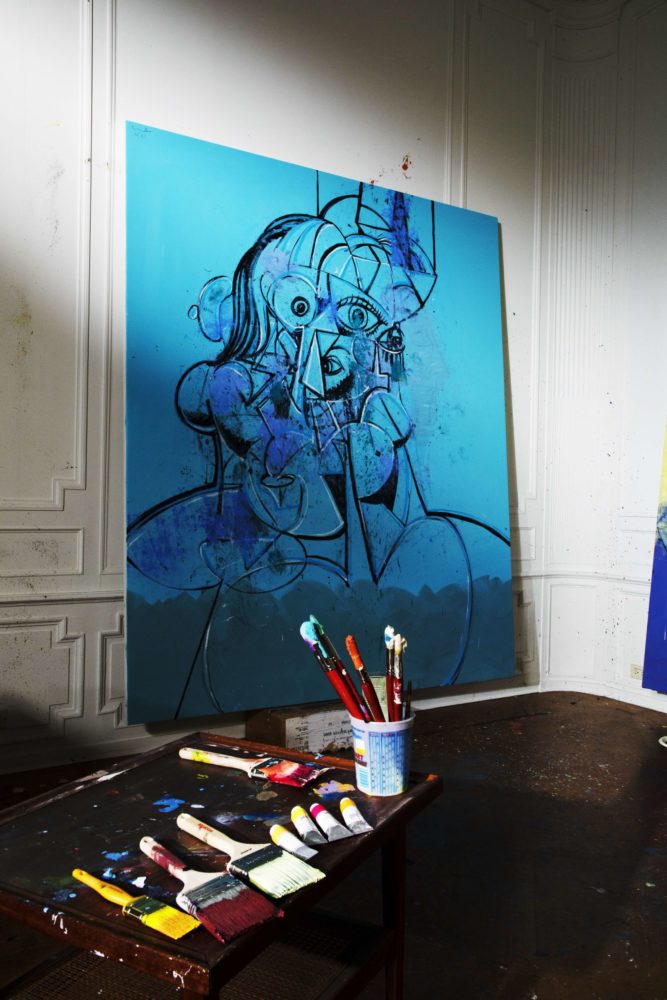 George Condo’s New York studio, photo by Steve Benisty.
George Condo’s New York studio, photo by Steve Benisty.
WW: Do you remember the songs you’re listening to when work on each painting?
GC: You remember the chord changes, you remember the harmonies, you remember all the notes that are involved and all the brushstrokes, but you never want to repeat them, you just want them to be an endless stream of showing, in a way, your ability to invent a new thing each time with the same setting. Like the same song with a brand-new lyric every time, or brand-new presentation of the improvisation. It’s all about improvisation for me.
WW: You have a show this fall at Hauser & Wirth in London. How will that work follow “Internal Riot”?
GC: I can already feel it. They are sort of families that have broken out of their cages. They’ve gone wild. They all run in 15 different directions at once. And all the figures are exploding out of the box. It’s a different kind of joy, to see that people are being liberated from these terrible restrictions. It will be different because “Internal Riot” was really that feeling of being locked. I could only experience all of this and internalize all of what was happening during the time through TV. I wanted to express that internal riot that I was going through in my own psyche into these paintings.
Now the show will be like wild animals let out of their cage, and it’s going to be, instead of internal, much more external. It will come from me, of course, but it will feel like a representation of a liberation, to a certain extent. I’ve done a good six paintings for the show already, and they feel like a completely different color palette, and, in a very sort of weird way, I’m wiping out the feelings I had during that time and I’m showing that—painting them over. Sort of like trying to put it behind me, the whole experience of the pandemic, and now looking toward the future. The wildness of what these paintings represent will be this feeling of liberation. They are going to be about what you could do next.
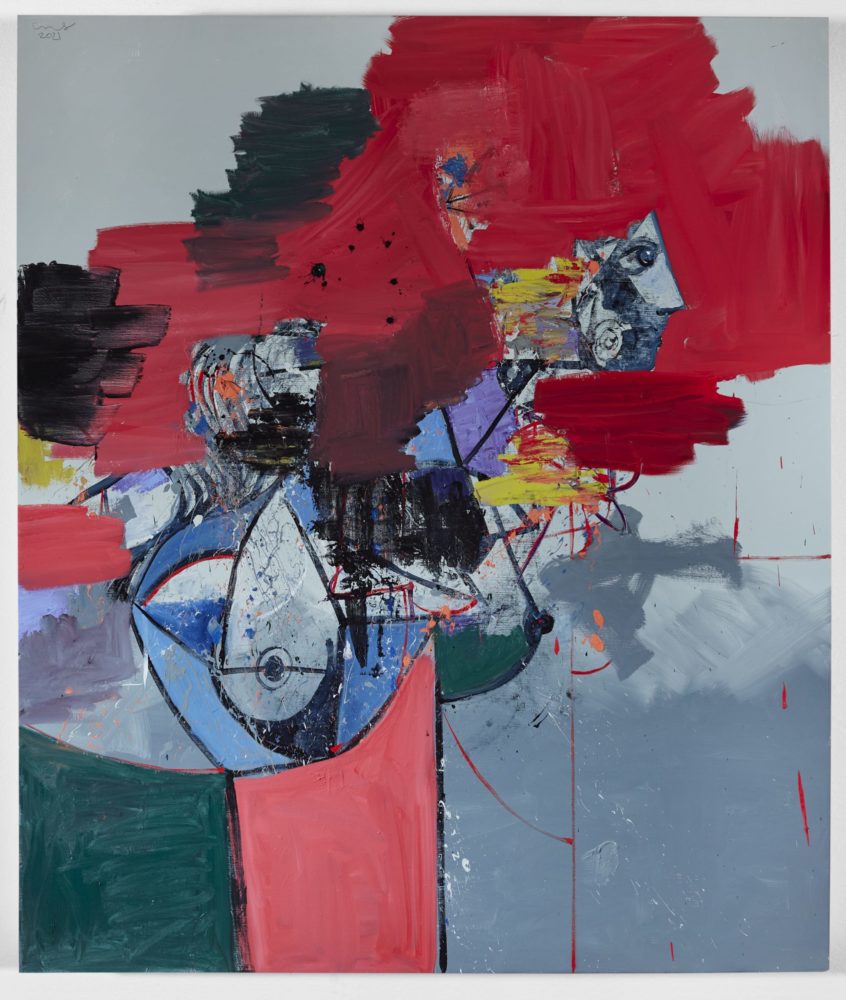 George Condo, “The Shattered Life,” 2021, Oil on canvas, 90 x 75 inches; courtesy of the artist and Hauser & Wirth.
George Condo, “The Shattered Life,” 2021, Oil on canvas, 90 x 75 inches; courtesy of the artist and Hauser & Wirth.






